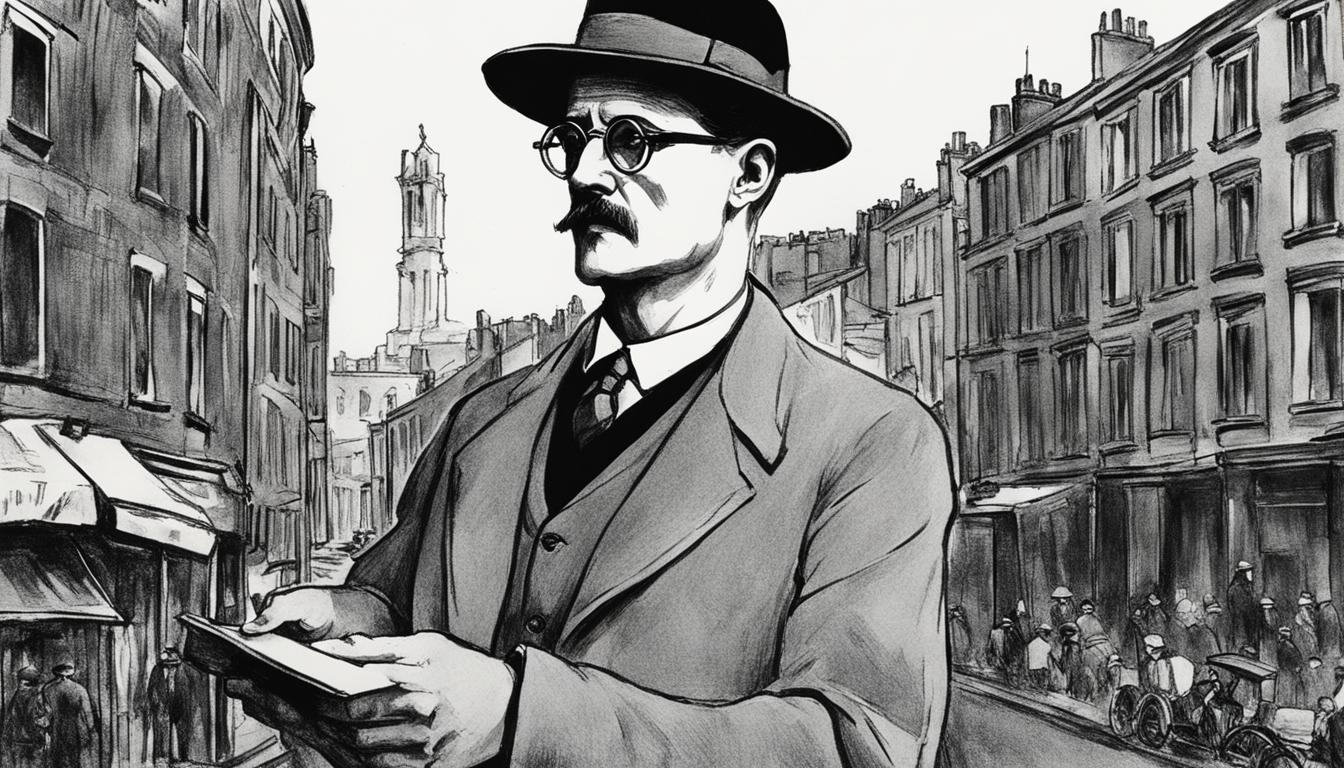Welcome to our comprehensive audiobook review of “Ulysses” by James Joyce. This iconic novel, first published in 1922, continues to captivate readers today and is considered one of the most innovative works of modernist literature. In this article, we will provide an in-depth analysis of the audiobook version of “Ulysses,” exploring its complex narrative, historical significance, and impact on the literary world. Join us as we delve into the intricacies of this masterpiece, examining its plot, characters, themes, and cultural context.
This article will be useful for anyone interested in learning more about audiobook reviews, James Joyce, or the novel “Ulysses.” We aim to provide keen insights that enrich your understanding and appreciation of this literary classic.
Understanding the Historical Context
To fully appreciate James Joyce’s masterpiece “Ulysses,” it is crucial to understand the historical context in which it was written. Set in the early 20th century, Joyce’s work was greatly influenced by the socio-political events of the time. These factors shaped the themes explored in the novel and provided a backdrop for the characters and their struggles.
During this period, Europe was experiencing significant change and tumultuous events such as World War I, the Irish War of Independence, and The Russian Revolution were shaping the political and social landscape. These events had a profound effect on Joyce and can be seen reflected in his work, particularly in the themes of identity, nationalism, and religion.
In addition, the literary movement of modernism was beginning to emerge, and Joyce was at the forefront of this experimental style of writing. Modernism was characterized by its rejection of traditional narrative structures and its innovative use of language and symbolism. Joyce’s unique literary techniques, such as stream-of-consciousness and internal monologue, were groundbreaking in their time and continue to influence writers to this day.
By understanding the historical context in which “Ulysses” was written, readers can gain a deeper appreciation for the themes and literary techniques employed by Joyce. By examining the socio-political events of the time, we can better understand the impact this period had on Joyce and his writing, and how it has contributed to the enduring legacy of “Ulysses.”
Unraveling the Plot of “Ulysses”
“Ulysses,” considered a masterpiece of modernist literature, boasts a complex and non-linear narrative that can be difficult to follow. However, a closer examination of the plot structure and character development reveals the genius of James Joyce’s writing.
The novel takes place over the course of a single day – June 16, 1904 – in Dublin, Ireland. The story follows two central characters, Leopold Bloom and Stephen Dedalus, as they navigate the streets of the city.
The plot is comprised of 18 episodes that vary widely in style, structure, and format. Some chapters are written in the form of a play, while others use stream-of-consciousness narration. Each of these episodes showcases a different aspect of Dublin life and explores a range of themes related to identity, religion, and sexuality.
As readers traverse the different sections of the novel, they encounter an array of supporting characters, each of whom adds to the tapestry of Joyce’s Dublin. From the scheming Buck Mulligan to the anxious Molly Bloom, each character has a unique voice and perspective that contributes to the overall richness of the narrative.
| Episode | Character | Significance |
|---|---|---|
| Telemachus | Stephen Dedalus | The opening episode establishes the novel’s central themes and introduces us to Stephen’s troubled relationship with Buck Mulligan. |
| Nestor | Stephen Dedalus | This episode features an extended conversation between Stephen and his employer, Deasy, which explores themes of nationalism and anti-Semitism. |
| Proteus | Stephen Dedalus | Stephen wanders along the beach and reflects on his life and artistic aspirations in this poetic and introspective chapter. |
| Calypso | Leopold Bloom | Bloom prepares breakfast for his wife, Molly, and reflects on his own feelings of isolation and grief in this domestic episode. |
| Oxen of the Sun | Various | This episode imitates the styles of different historical phases of English literature while exploring the themes of conception, birth, and fertility. |
| Circe | Various | This hallucinatory and highly experimental episode takes place in a brothel and blends reality and fantasy, exploring themes of power and sexuality. |
Despite its complexity, Joyce’s intricate plot structure ultimately weaves together a powerful exploration of the human experience. Join us as we further examine the themes of “Ulysses” in the following sections.
Character Study: Leopold Bloom
Leopold Bloom is undoubtedly the most enigmatic character in Ulysses. The novel explores his life over a 24-hour period, as he navigates through Dublin, encounters various individuals, and confronts his existential fears and dreams. Bloom’s character has been the subject of intense scrutiny, and his motivations and desires continue to baffle readers today.
To understand the complexity of Bloom’s character, it’s essential to explore his background and history. Born into a Jewish family, Bloom experiences discrimination and marginalization from Irish society. This sense of alienation shapes his identity and informs his outlook on life. As we follow his journey throughout the novel, we witness his struggle to reconcile his Jewish heritage with his desire to assimilate into Irish culture.
Bloom’s character is also defined by his relationships with other characters, particularly his wife, Molly. Their marriage is fraught with tension, infidelity, and misunderstanding, and this dynamic reflects the complexities of human relationships. Through Bloom’s interactions with other characters, we gain insight into his fears, desires, and the vulnerabilities that shape his personality.
“I am a Jew and he is not. My religion, my nation, my race. I taught him to say Mammy before he could walk. He is Jewish. I am a Jew. And that was an Irishman’s housewarming!” – Leopold Bloom, Ulysses
Exploring Dublin: the Novel’s Setting
In “Ulysses,” Dublin is more than just a location; it becomes a character in and of itself. Joyce’s vivid descriptions highlight the city’s architecture, people, and culture, creating a rich and immersive setting that serves as a backdrop to the narrative.
The author’s deep familiarity with the city’s streets and landmarks lends authenticity to the setting, capturing the essence of Dublin in the early 20th century. The novel takes readers on a literary tour, exploring various neighborhoods, pubs, and monuments.
The city’s vibrant atmosphere provides the perfect backdrop for the characters’ inner struggles and external conflicts. As Bloom wanders through the streets, his introspective wanderings mirror the city’s ever-changing landscape.

The Role of Dublin in the Narrative
From the beginning of the novel, Dublin sets the stage for the unfolding of events. The city is central to the defining moments in the characters’ lives, and their relationships with their surroundings are woven into the fabric of the narrative.
The theme of identity is perpetually entwined with the physical landscape, as characters confront their past and present selves within the city’s boundaries. As the novel progresses, the city’s role becomes more pronounced, culminating in the dizzying final chapter that showcases Dublin’s intricate web of life.
“I want to give a picture of Dublin so complete that if the city suddenly disappeared from the earth it could be reconstructed from my book.” – James Joyce
Ultimately, Joyce’s intimate knowledge of the streets and landmarks of Dublin elevates “Ulysses” beyond a mere novel and transforms it into a celebration of the city’s unique character and spirit.
Literary Techniques in “Ulysses”
In “Ulysses,” James Joyce employs various literary techniques that epitomize his innovative writing style, leaving an indelible mark on modernist literature. One of the most prominent techniques used is stream-of-consciousness, allowing readers to delve into the innermost thoughts of characters in a seemingly random and nonlinear fashion. Joyce also employs internal monologue, where characters reflect on their experiences and emotions, providing insight into their psyche and motivations. Additionally, Joyce uses extensive wordplay, puns, and allusions throughout the novel, creating a rich and complex literary tapestry. These techniques not only enhance the reading experience but also convey the novel’s themes of identity, memory, and the human condition.
Themes Explored in “Ulysses”
“Ulysses” is a novel that explores several themes that go beyond the surface level of the narrative. James Joyce delves into the intricacies of identity, sexuality, religion, nationalism, and more, as he imbues the novel with a sense of philosophical inquiry.
The themes explored in “Ulysses” are relevant today as they were when the novel was first published in 1922. Joyce raises profound questions that compel readers to reflect on their understanding of the world, their place within it, and their perceptions of others.
In exploring themes of identity, the novel presents us with two central characters – Leopold Bloom and Stephen Dedalus – who are at odds with their sense of self. In the context of early 20th century Ireland, the theme of identity takes on a larger significance, as the country struggles to define itself in the face of colonialism and political upheaval.
Sexuality is another theme that pervades “Ulysses,” as Joyce presents unconventional portrayals of desire and intimacy. The character of Molly Bloom subverts traditional notions of femininity and sexuality, while Leopold Bloom navigates a complex relationship with his spouse and confronts his own desires.
The theme of religion is also central to the novel, as Joyce critiques the role of the church in the lives of the Irish people. He questions the validity of religious doctrine and explores the tension between faith and doubt.
“Ulysses” is a novel that resists easy definition, and its themes contribute to this sense of complexity and ambiguity. Joyce challenges readers to engage with the philosophical questions raised by the text, and the enduring legacy of the novel speaks to the profundity of its themes.
Historical and Cultural Significance
Beyond its literary merit, “Ulysses” holds immense historical and cultural significance. James Joyce’s novel was published in an era of political and social upheaval, making it a reflection of the times in which it was written. The novel, with its innovative writing style and controversial themes, had a profound impact on the literary world, paving the way for modernist literature and experimentation with form and narrative.
The novel also faced allegations of obscenity, leading to a notorious censorship trial in the United States, where it was eventually allowed to be published freely. “Ulysses” challenged the conservative views of its time, breaking down taboos surrounding sexuality, religion, and politics. Its enduring influence on subsequent generations of writers is a testament to its cultural impact.
“Ulysses” changed the literary landscape forever, inspiring future generations of writers to experiment with narrative techniques and themes that were once considered taboo.
Joyce’s Writing Style in “Ulysses”
James Joyce’s writing style in “Ulysses” is unique and complex, and it is a significant factor contributing to the novel’s literary impact. Joyce’s narrative techniques, use of language, and symbolism come together to create a captivating masterpiece that challenges readers to think deeply.
One notable aspect of Joyce’s writing style is his use of stream-of-consciousness narration, a technique that presents the character’s thoughts, impressions, and perceptions in a continuous and uninterrupted flow. This technique can be seen in the opening of the novel, where the reader is introduced to the character of Stephen Dedalus. The language used is rich and evocative, building up a vivid picture of the setting and the character’s inner world.
In addition to stream-of-consciousness narration, Joyce employs a range of other literary techniques throughout “Ulysses.” These include internal monologue, wordplay, and references to literary works, all of which contribute to the novel’s complexity and depth. The use of different writing styles throughout the novel also adds to its unique character, such as the episode “Oxen of the Sun,” which parodies different styles of English literature from the medieval to the modern.
“His writing represents the epitome of literary modernism, blending the inner and outer worlds of the characters and pushing the boundaries of traditional narrative style.”
Finally, Joyce’s use of language and symbolism is an integral aspect of his writing style. The novel contains numerous biblical, mythological, and historical allusions, and Joyce uses these to add depth and texture to the narrative. The use of puns and wordplay also contributes to the novel’s comedic elements, highlighting the range of Joyce’s literary talents.
Literary Techniques in Ulysses
| Literary Technique | Description |
|---|---|
| Stream-of-consciousness narration | Presents character’s thoughts without interruption |
| Internal monologue | Reveals character’s inner world |
| Wordplay | Adds elements of puns and comedy to the narrative |
| Allusions | Biblical, mythological, and historical references that enrich the narrative |
Through these unique qualities and techniques, Joyce’s writing style in “Ulysses” vastly differs from traditional narrative writing and allows readers to fully immerse themselves in the story. Joyce’s writing style in “Ulysses” is unlike any other and contributed to the novel’s acclaim that has persisted for over a century.
Audiobook Narration and Performance
The audiobook version of “Ulysses” offers a unique experience of engaging with James Joyce’s complex narrative. The success of an audiobook depends on both the quality of the text and the skill of the narrator. Fortunately, the “Ulysses” audiobook presents an exceptional standard, thanks to the excellent narration of actor Jim Norton.
Norton provides a rich and captivating narration that delivers the nuances of Joyce’s language and style. His expressive performance brings the characters to life, from the comforting and familiar voice of Leopold Bloom to the exuberant and vivacious depiction of Molly Bloom’s soliloquy. Norton’s mastery of different accents, including Irish and British, adds authenticity and depth to the audiobook presentation.
Furthermore, the “Ulysses” audiobook presents some additional features that enhance the overall listening experience. For example, the recording includes sound effects that evoke the ambiance of different settings in the novel, such as the bustling streets of Dublin or the tranquil seaside at Sandymount Strand. The audiobook also includes a recorded introduction by Joyce scholar Declan Kiberd, offering insightful commentary and valuable historical context.
Comparing Audiobook Versions
While the Norton-narrated version of “Ulysses” is highly recommended, it’s essential to note that there are other audiobook editions available. For example, the Penguin Classics edition features a full-cast dramatization of the novel, with different actors playing various characters. However, this edition has received mixed reviews, with some critics finding the dramatization distracting and detracting from the novel’s literary merit.
Another noteworthy version is the Naxos AudioBooks edition, narrated by Marcella Riordan and read word-for-word from the Gabler edition of the text. Riordan’s narration has been praised for its clarity and precision, but some reviewers find it lacking in the emotion and expressiveness that Norton brings to his reading.
“Listening to the “Ulysses” audiobook version offers a new dimension to experiencing Joyce’s epic novel, taking readers on a journey through the streets of Dublin and into the minds of its diverse characters. Jim Norton’s impeccable narration provides an enthralling performance that captures the essence of Joyce’s writing.”
Criticisms and Controversies
“Ulysses” has received high praise for its literary evocation of Dublin and its experimental style of narration. However, despite its critical acclaim, the novel has faced criticism and controversies from various sources.
One of the most prominent controversies surrounding the book concerned its obscene content. In 1922, “Ulysses” was banned in the United States for being “obscene,” and importers were prosecuted for distributing copies of the book. The legal battle to lift the book’s ban lasted for over a decade, with the novel finally declared non-obscene in 1934.
Another criticism of “Ulysses” is its complex and challenging language style, which some readers find hard to comprehend. The novel’s stream-of-consciousness narration, playful wordplay, and inventive poetics have been the subject of both admiration and controversy, with some critics arguing that the style sacrifices clarity and narrative coherence for the sake of experimentation.
“The style is chaotic, the language obscure, the wit random, and the characters isolated and disjunctive. The book requires more energy than it is worth, and if it has any value, it is in the way it exposes the symptoms of a diseased mind.” – Edmund Wilson
Finally, some readers and critics have taken issue with the representation of women in the book, arguing that Joyce’s portrayal of female characters is sexist and derogatory. For instance, Molly Bloom’s famous soliloquy has been both praised as a triumph of feminist sensibility and criticized as an objectification of female sexuality.
| Criticism | Controversy |
|---|---|
| Obscene content | Banned in the US for several years |
| Challenging language style | Subject of admiration and controversy |
| Sexist portrayal of women | Contested representation of female characters |
Despite these critiques and controversies, “Ulysses” remains widely regarded as a classic work of modernist literature, and its experimental style has influenced countless writers in the years since its publication.
Legacy and Influence
Over the years, “Ulysses” has cemented its place as a landmark in modernist literature. James Joyce’s legacy is one that is synonymous with literary innovation, and “Ulysses” serves as the epitome of his literary genius. The novel’s impact continues to be felt in contemporary literature, with subsequent generations of writers inspired by Joyce’s experimental style and complex narrative structure.
The influence of “Ulysses” extends beyond literature, permeating popular culture and academia. The novel has been the subject of numerous adaptations, from theatrical performances to operas and films. Its sheer cultural significance and artistic merit have earned Joyce a place among the canon of Irish literature.
The ongoing discussion and scholarship surrounding “Ulysses” is a testament to its enduring relevance. While some readers may find Joyce’s style daunting, his innovations have inspired countless others and opened new avenues for future writers to explore. Joyce’s contribution to the literary world has been immeasurable, and “Ulysses” stands as a testament to his artistic vision and creative spirit.
Reception and Awards
Upon its publication, “Ulysses” was met with controversy and censorship, but over time, it has come to be recognized as an iconic literary masterpiece. The critical reception of the novel has evolved to reflect its enduring influence and cultural significance.
The first U.S. edition of “Ulysses” was published by Random House in 1934 after a court ruling overturned the ban on the novel, citing its literary merit. Since then, it has been featured on numerous “Best of” lists and has earned high praise from literary critics, including:
| Publication | Award or Honor | Year |
|---|---|---|
| Nobel Prize in Literature | James Joyce | 1922 |
| Time | 100 Best Novels in English-Language | 1923-present |
| Modern Library | 100 Best Novels | 1998 |
| The Guardian | 100 Best Novels Written in English | 2015 |

The enduring legacy of “Ulysses” is reflected in the critical acclaim and numerous awards the novel has garnered over the years. Joyce’s groundbreaking work has set a standard for innovation in literature against which contemporary works are often measured.
Reading Recommendations
For those who have enjoyed the literary prowess of “Ulysses” by James Joyce, there is a treasure trove of his other works waiting to be explored. Below we have curated a list of recommended readings to delve deeper into his literary repertoire:
| Title | Publication Year |
|---|---|
| Portrait of the Artist as a Young Man | 1916 |
| Dubliners | 1914 |
| Finnegans Wake | 1939 |
| Exiles | 1918 |
If you want to further explore Joyce’s groundbreaking contribution to modernist literature, his poetry and critical writings are also worth delving into.
“Perhaps I am a man of a bygone age,” Joyce once said, “but I would like to believe that my books transcend time.”
Conclusion
Our comprehensive audiobook review of James Joyce’s “Ulysses” has provided a detailed exploration of the complex narrative, intricate characters, historical significance, and lasting impact of this iconic work. Through examining the socio-political context, plot structure, literary techniques, themes, and cultural controversies, we hope to have enriched your understanding and appreciation of this literary masterpiece.
By immersing ourselves in the vibrant setting of Dublin and analyzing the unique writing style of James Joyce, we have unpacked the layers of meaning and philosophical questions raised by “Ulysses.” We have also evaluated the narration and performance of the audiobook version, highlighting its strengths in bringing Joyce’s work to life.
Despite facing criticism and censorship battles, “Ulysses” has cemented its place in the literary canon and continues to inspire subsequent generations of writers. From its reception upon publication to its numerous accolades and influence on contemporary literature, “Ulysses” has left an indelible mark on the literary landscape.
For readers who have been captivated by “Ulysses” and seek to explore more of James Joyce’s works, we recommend delving into his other masterpieces such as “Dubliners,” “A Portrait of the Artist as a Young Man,” and “Finnegans Wake.”
Overall, our review of “Ulysses” aims to provide insight into this literary classic, encouraging readers to engage with the complexities of its narrative and appreciate the lasting impact it has had on literature.



